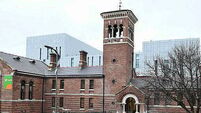Ceannt ‘remarkably fortunate’ to discover sculpture after near-fatal accident

By Cillian Sherlock, PA
A grandnephew of one of the 1916 Rising leaders says a near-fatal accident changed the course of his life.
Acclaimed Irish sculptor Eamonn Ceannt stumbled into a sculpture class that helped him recover from his devastating injuries, sustained after diving into a swimming pool.
Now the 72-year-old is preparing for Choreo, a semi-retrospective exhibition of his work at Gormleys Gallery in Dublin later this month.
Mr Ceannt, a grandnephew of the 1916 leader of the same name, says he was “extraordinarily lucky to have found sculpture”.

In 1991, at the age of 39, he dived into a swimming pool in Dublin and broke his neck, causing him to go into a period of paralysis.
His injuries also led to nerve damage in his arms and hands.
Some years later, he was attending painting classes in the National College of Art and Design and wandered into the sculpture room where students were working with clay, kneading it with their hands.
“I realised that’s exactly what I should do from a physical therapy point of view, even though it was purely accidental,” said Mr Ceannt, who was then working at State Forestry Agency, Coillte.
He subsequently worked as vice-president at University College Dublin (UCD).
“The accident was immense – it was such a shock to the system. The fifth vertebrae in my neck was removed and a piece of my hip was slotted in.
“I should have been in rehab for the rest of my life,” said Mr Ceannt, who lives in Dublin.
“I was at a point of saying, as soon as the kids are grown, I’m going to have to change my life. I was given a ghastly example of just what that can be.
“My journey in sculpture has been convoluted. When I was younger, I was always drawing. After the accident, I moved to Africa for a number of years, and when we returned, I was looking to get back into doing some art.”

The father-of-three said he did not have the delicate control for drawing, but one day wandered into the sculpture class.
“My own hands had been wasting because of nerve damage, but they have since gained a lot of their strength through sculpture – I was remarkably fortunate to find it,” he said.
“From a physical therapy point of view, it was the best thing I could have fallen into.”
His forthcoming exhibition, Choreo, showcases a series of bronze sculptures inspired by the elegance and dynamism of dance, opera and ballet, drawing on Ceannt’s lifelong love of dance as “one of the purest athletic forms”.
His sculptures capture moments of movement, emphasising form and the juxtaposition of soft curves and planes.
Each piece invites viewers to experience the vitality and elegance of dance through the medium of bronze.
A semi-retrospective show, Choreo features some of the artist’s earlier work alongside brand-new work inspired by iconic figures from the world of dance, including Odette, the swan princess from Swan Lake.
Choreo runs at Gormleys Dublin Gallery from October 23rd to November 15th, and admission is free.






